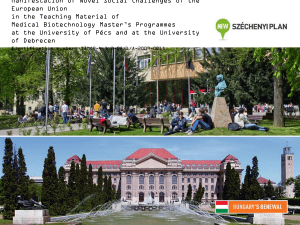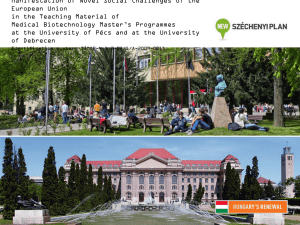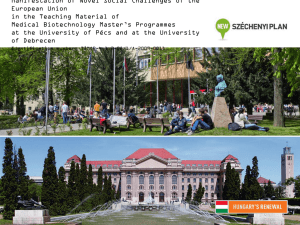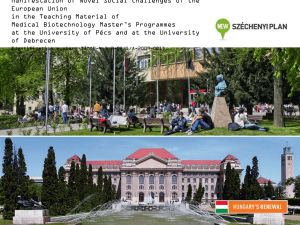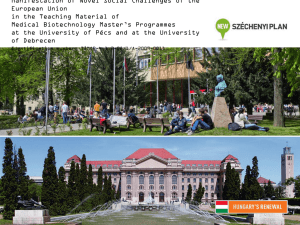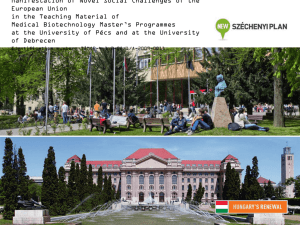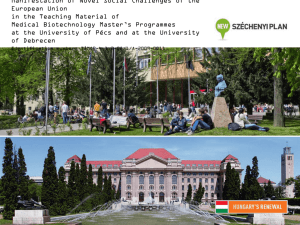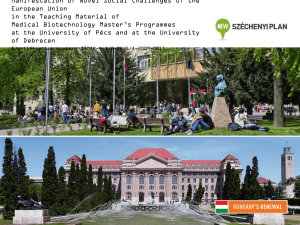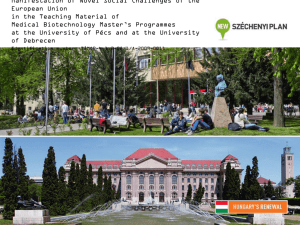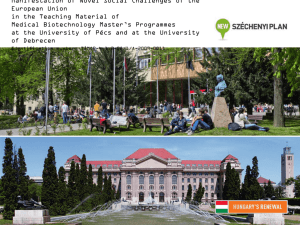Receptor interactions signaling cross-talk
advertisement
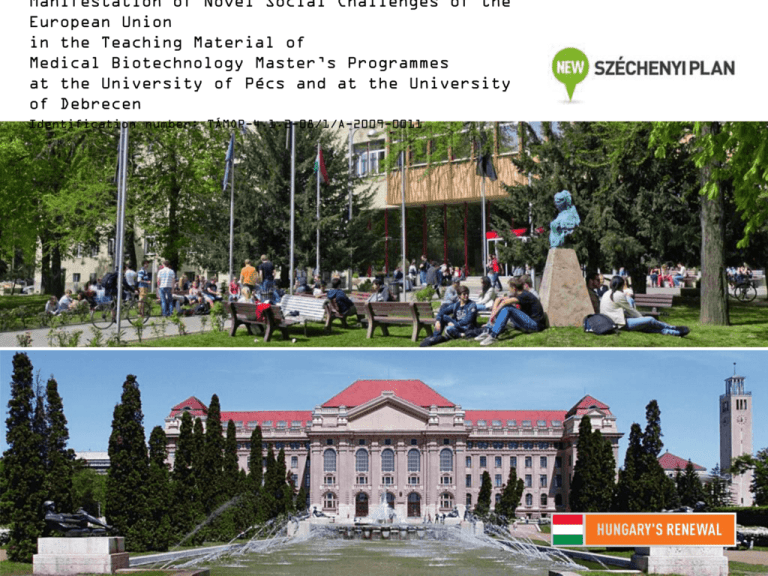
Manifestation of Novel Social Challenges of the European Union in the Teaching Material of Medical Biotechnology Master’s Programmes at the University of Pécs and at the University of Debrecen Identification number: TÁMOP-4.1.2-08/1/A-2009-0011 Manifestation of Novel Social Challenges of the European Union in the Teaching Material of Medical Biotechnology Master’s Programmes at the University of Pécs and at the University of Debrecen Identification number: TÁMOP-4.1.2-08/1/A-2009-0011 Tímea Berki and Ferenc Boldizsár Signal transduction RECEPTOR INTERACTIONS SIGNALING CROSSTALK TÁMOP-4.1.2-08/1/A-2009-0011 Introduction • Although there is a need for the precise separation of certain pathways to maintain the specificity of signals, upon complex physiological stimuli more pathways might be active in parallel. This creates a basis for interaction between active pathways. • Signaling pathways form a “network”. • Some proteins can participate in multiple pathways. TÁMOP-4.1.2-08/1/A-2009-0011 Mechanisms of interaction • Synergism/antagonism • Direct protein interactions – large signaling complexes, organized by scaffold proteins and the cytoskeleton • Phosphorylation/dephosphorylation • Importance: when targeting a pathway never forget about potential interactions with other pathways! TÁMOP-4.1.2-08/1/A-2009-0011 Levels of signal “crosstalk” • Cell surface receptors • Plasma membrane proximal signaling complexes • Cytoplasmic signaling complexes • Pathway merging / branching • Transcription factors More receptors using the same second messenger system TÁMOP-4.1.2-08/1/A-2009-0011 ACTH LH FSH Secretin Adrenaline Adenylyl cyclase ATP cAMP Glucagon Growth factor receptor – integrin signaling interaction TÁMOP-4.1.2-08/1/A-2009-0011 ECM Growth factors Integrins PI3K PTEN IRS1 - ILK IBPs Pinc h Nck2 + GSK3 + -catenin LEF1 PKB + - + AP1 Suppression of apoptosis Angiogenesis Cycli ns Invasion, proliferation Cadherins TÁMOP-4.1.2-08/1/A-2009-0011 EGF signaling EGF Vav2 EGFR PTP + E2Ub H2O2 - - NADPH synthesis Cdc42 /Rac Rac STAT3 IP3 Gab1 DAG SOS Shc + STAT1 PLC GRB2 Cbl - - PI3K Target genes Ca2+ PKC Ras Src MEKK PIP3 MEKK4 Akt MKK2 ADAM PDK1 MAPKK MKK4 Targets MAPK p38 JNK Bad FKHR - Raf MAPK DOK Targets Ras GAP Nck + GRB2 FAK HB-EGF Gab1 PAK1 RSK2 p53 Jun CFos AP1 MAPK Cell cycle Paxillin Shp2 CAS JNK WASP Apoptosis CREB Src Cytoskeleton Rac TÁMOP-4.1.2-08/1/A-2009-0011 General characteristics of GF signaling Input layer Diverse input signals (Multiple RTKs) + Conserved core processes System control + + Diverse ouput events (transcriptional responses, cytokeletal changes, etc) Output layer TÁMOP-4.1.2-08/1/A-2009-0011 Ras – an important signaling switch EGFR P P P P P P P P K-RAS mutation controls 75% of EGFR-pathway GRB2 B-RAF mutation: 1/4 EGFRpathway PTEN mutation: 1/4 EGFR pathway PI3K mutation: 1/4 EGFR pathway PI3K3R1 PI3K3CA SOS Akt Ras mTOR BRaf PTEN PLCe PLC PKC JAK STAT1/3 RAS-independent Erk TÁMOP-4.1.2-08/1/A-2009-0011 BcR and FcβRIIB cross-talk Simultaneous cross-linking BCR FcRIIB a PIP2 LYN ITIM P SHIP DOK Iga SHC PIP3 No membrane recruitment BTK Ig RAS Inhibition of calcium flux and proliferation PLC Non-genomic GR signaling – interaction of GR with cytoplasmic TcR signaling proteins TÁMOP-4.1.2-08/1/A-2009-0011 • Heat shock proteins (chaperons) organize multiprotein complexes • GR associates with Hsp-90 and ZAP-70 TCR TCR a a Plasma membrane d e e zz d e e Lck zz Cytoplasm HSP90 P ZAP70 HSP90 ? TÁMOP-4.1.2-08/1/A-2009-0011 TNFR – GR cross-talk I TNF GC Plasma membrane TNFR Cytoplasm Chaperone complex GR MAPK inactivation MAPK TF Nucleus Induction of anti-inflammatory genes Tethering of pro-inflammatory TF GILZ, MKP-1, TTP, IBa TF GRE TFRE Inhibition of RNA Pol-II phosphorilation pTEF Cofactor competition P TF RNA Pol-II TF RNA Pol-II TF TF TFRE TFRE TFRE TFRE Chromatin modulation: HDAC Chromatin modulation: recruitment MSK1 removal MSK1 MSK1 TF TF AC TFRE HDAC2 P TF AC AC TFRE TFRE P H3 TF TFRE H3 TÁMOP-4.1.2-08/1/A-2009-0011 TNFR – GR cross-talk II TNF TNF GC TNFR Plasma membrane TNFR Cytoplasm GR ROS TF Transcription factors like: NFkB, AP-1, IRFs,... MAPK Nucleus Cofactor competition GR TF ROS TF TFRE HDAC2 GRE TÁMOP-4.1.2-08/1/A-2009-0011 Transcription factor crosstalk + : Induction of transcription – : Inhibition of transcription Composite RE TF-RE GRE Lapping RE Oct-1 + AP-1 – AP-1 – TFIID – CREB + NF-kB – NF-B – Oct-1 – Ets1 + PU.1/Spi-1 – PU.1/Spi-1 – AP1(cJun:cJun + SMAD3,4 – STAT5 – C/EBP – T-bet – COUP-TFII – Oct1/2 – T-bet – STAT6 – SMAD6 – IRF3 – Oct1/2 + AP1(cJun:cFos) – COUP-TFII STAT5 + + TÁMOP-4.1.2-08/1/A-2009-0011 Convergence of signaling pathways Platelets Circulating cells and mediators EGF TNFa ANG II PDGF 5HT (serotonin) ALK/End or BMPR 1-2 Cell surface receptors BMPs or TGF 5HT transporter P O-2 Angiopoiethin G protein NO SMADs TIE Endothelin B A VEGF KDR MAP Kinase s ERK JNH K+ channels Apoptosis SMC tone ES Recepto r Gene activation or repression Other products Elastase Tenascin-c NO restores hypoxia blocks Intracellular signalling Growth Nuclear Transription Factors Cytokines AML ↓Apoptosis Apoptosis Anorexigens Proliferative phenotype Virus infection? HIV, HHV-8 Estrogen

